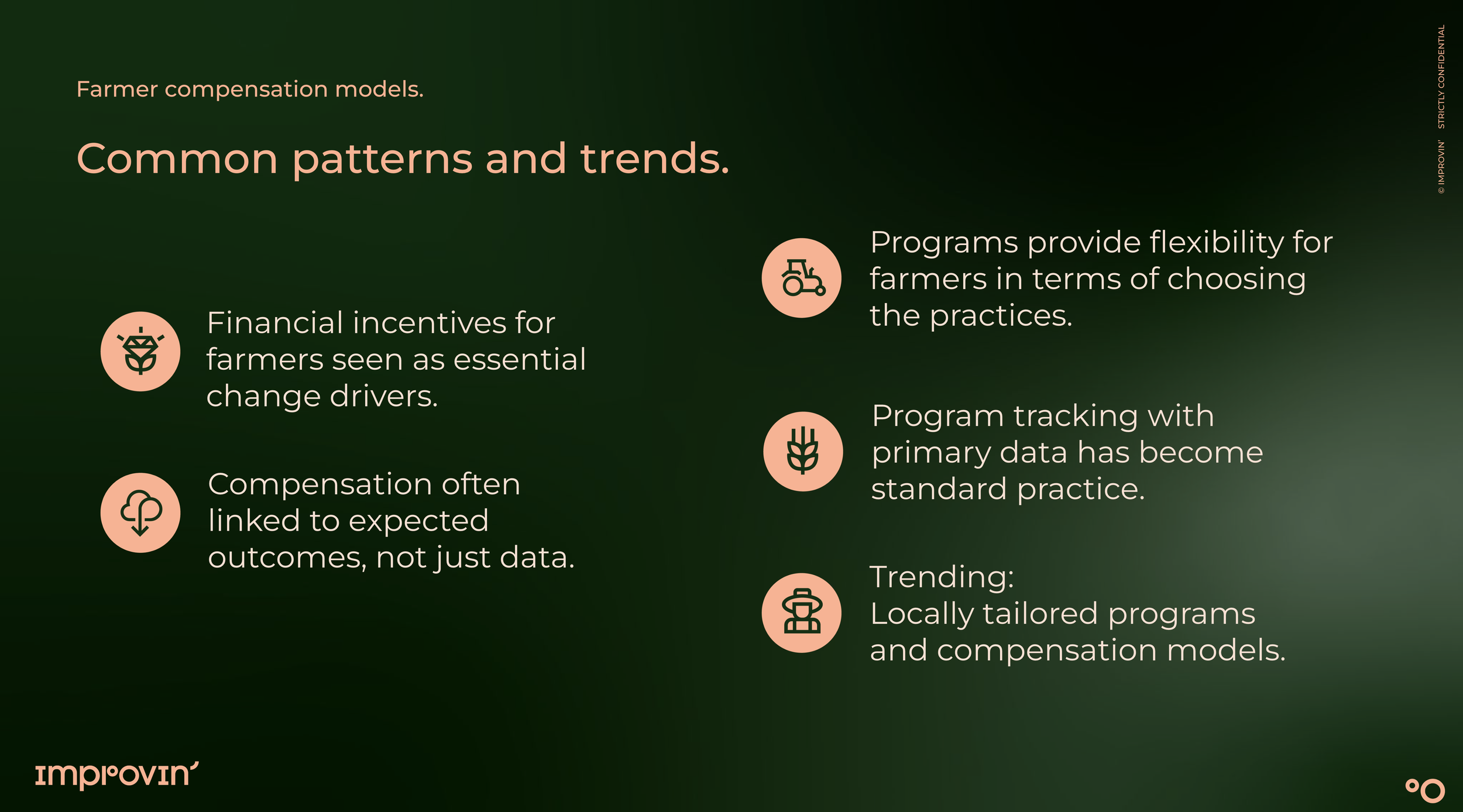Farmer compensation models: Market observations.
Key takeaways
Farmer compensation models typically fall into three categories: compensation for data, existing performance or implemented change (based on activities or outcome).
Compensation for implemented change is becoming increasingly common.
Primary-data-based farmer reporting has become a standard component of sustainability programs; setting a baseline and ensuring progress and results are tracked.
Scaling farmer programs calls for reliable digital infrastructure for data collection, tracking, quantifying and commercializing the results.
Introduction.
As agri-food companies work towards their environmental targets, many have recognized the potential in transforming how their key ingredients – such as grains, oils and sugar – are produced.
Modifying agricultural practices is seen as a lever for achieving large-scale emission reductions.
Agri-food companies are therefore opting to launch programs that incentivize farmers to adopt more sustainable practices, such as minimal tillage, healthy crop rotations, the use of cover crops and catch crops and optimized and adapted fertilizer and pesticide application.
As such programs have become more common, compensating farmers has emerged as a critical topic.
The industry is currently implementing and exploring various farmer compensation models. In this article, we examine the most common ones and highlight emerging trends and operational implications.
Overview of common farmer compensation models.
Several common approaches to compensating farmers have emerged in the market.
1 - Compensation for sustainability data.
Agri-food companies are at varying stages of their sustainability journeys. For many, the initial focus is on gaining an understanding of their value chain emissions baseline before implementing dedicated farmer programs.
For this, they need information from farmers regarding their current agricultural practices.
By gathering field-level primary data from farmers within their value chains, companies can transition from global default emission factors to precise primary-data-based emission calculations.
Many companies are therefore choosing to compensate farmers for reporting this information.
It’s worth noting that gathering the primary data from all farmers across one’s value chain can be an operational challenge. The easiest way to achieve this at scale is by using a reliable digital system, such as Improvin’.
2 - Rewarding farmer excellence.
With access to primary data, companies can assess the sustainability performance of the farmers they source from.
Farmers who demonstrate best-in-class performance can be rewarded, providing them and others in the market with a clear financial incentive to maintain and keep investing in new tools, technologies and sustainable practices, creating a positive feedback loop.
In this approach, a dedicated budget is typically allocated as a premium on the total volume of produce, distributed based on performance. Essentially, farmers are paid a market premium similar to low-carbon commodities trading.
This model is common when companies have established relationships with farmers, as it fosters close collaboration and ongoing support.
3 - Change-based compensation.
Finally, some companies are implementing dedicated programs designed to incentivize farmers to adopt new sustainable practices.
When these programs are launched, a predetermined budget is often allocated on a first-come, first-served basis, rewarding early adopters who commit to specific practices.
Compensation can be structured in two ways: Activity-based or Outcome-based.
Activity-based compensation
In this approach, the company outlines a specific set of practices and rewards farmers with a premium for implementing them.
Alternatively, the company may require certain activities for all their sourced volumes, making participation in the program a prerequisite for the trading relationship, while still rewarding farmers who fulfil the criteria with a premium.
Outcome-based compensation
Here, farmers are compensated based on the measured results of their implemented practices; often greenhouse gas emission reductions or removals (soil carbon sequestration).
Common patterns and emerging trends.
As companies explore different compensation models, common patterns and trends surface.
Financial incentives as change drivers.
Overall, financial incentives are seen as a crucial enabler for change. Many in the industry agree that without appropriate financial support or rewards, farmers will struggle to adopt and sustain new practices.
Compensation linked to (expected) results.
It is becoming more common to tie farmer compensation to actual change, such as the implementation of specific practices, rather than compensating for sustainability data alone.
Flexibility for farmers.
New programs are often designed with flexibility in mind, allowing farmers to select which practices they want to implement and report on.
This contrasts with more rigid schemes such as organic certification, where farmers must meet a list of extensive requirements to receive a market premium.
The granular approach gives farmers the freedom to adopt practices that best fit their operations, while still aligning with the company’s sustainability goals.
Traceability and reporting as standard practice.
Primary-data-based traceability is essential to the program setup. Most companies integrate reporting into their farmer programs to track progress and results.
Locally tailored compensation models.
Tailoring the programs and compensation models to the specific local needs of farmers, often in collaboration with local sourcing partners, is an emerging trend.
Operational implications.
Whether farmer compensation is based on reporting of data, current performance, implemented practices or achieved outcomes, a few operational implications are apparent.
Compensation is recognized as a key component of farmer sustainability programs, influencing program set-up, farmer engagement and expected reporting cadence.
As a result, many companies are seeing compensation as a focal starting point when planning new sustainability programs driving field-level impact.
Overall, the industry is becoming aware of the need for reliable digital infrastructure for launching and tracking farmer programs – particularly when scaling the programs from small, local tests to larger global efforts.
Large-scale projects require digital systems that can track and quantify the implemented agricultural practices and their results with reliable field-level primary data, at scale.
Improvin’s Sustainability Operating System provides the infrastructure for launching programs, tracking results with primary data, engaging and rewarding farmers as well as commercializing the outcomes.
See companies we work with and talk to our team to hear more.

